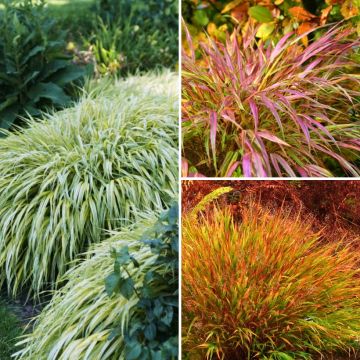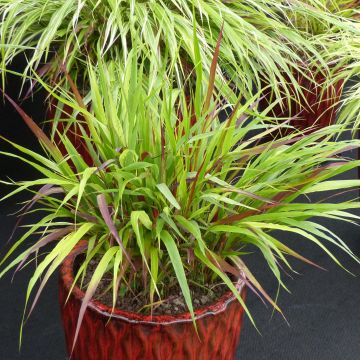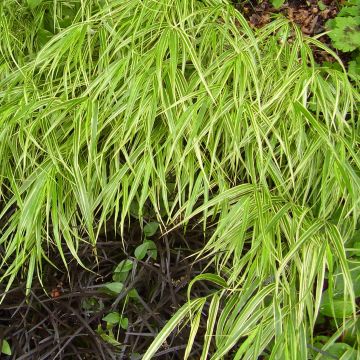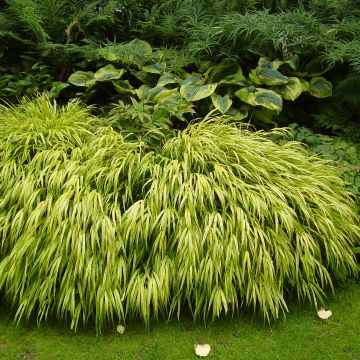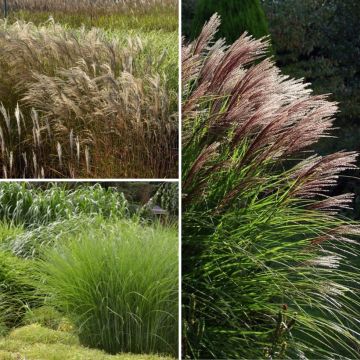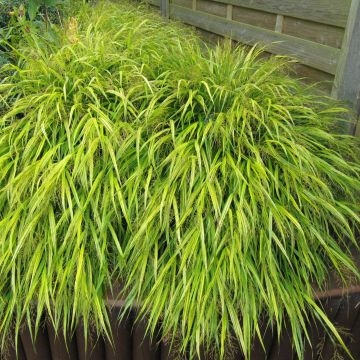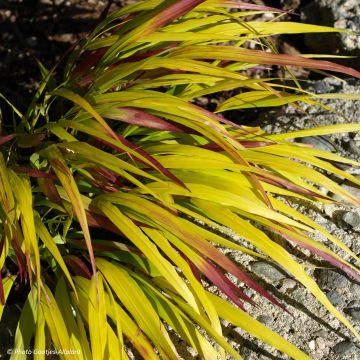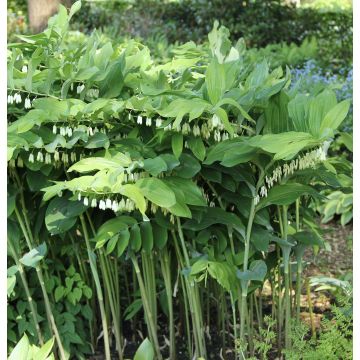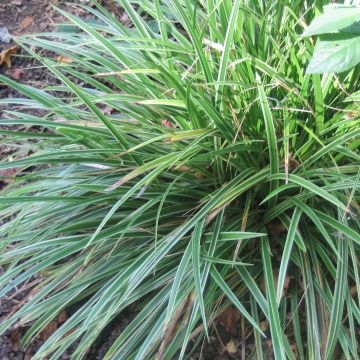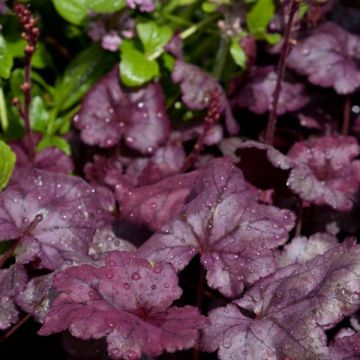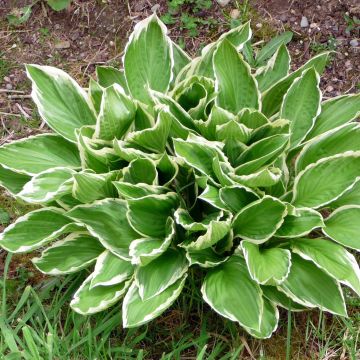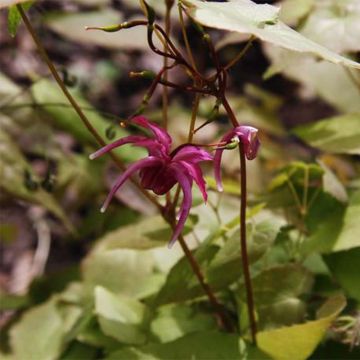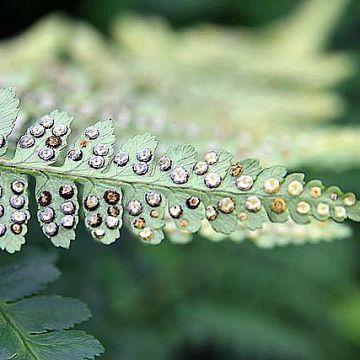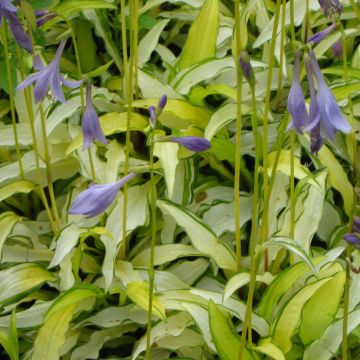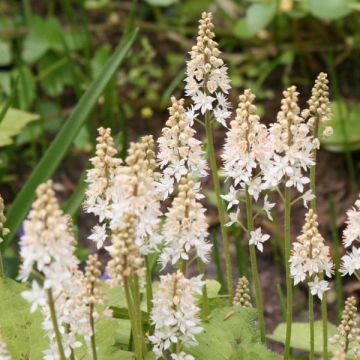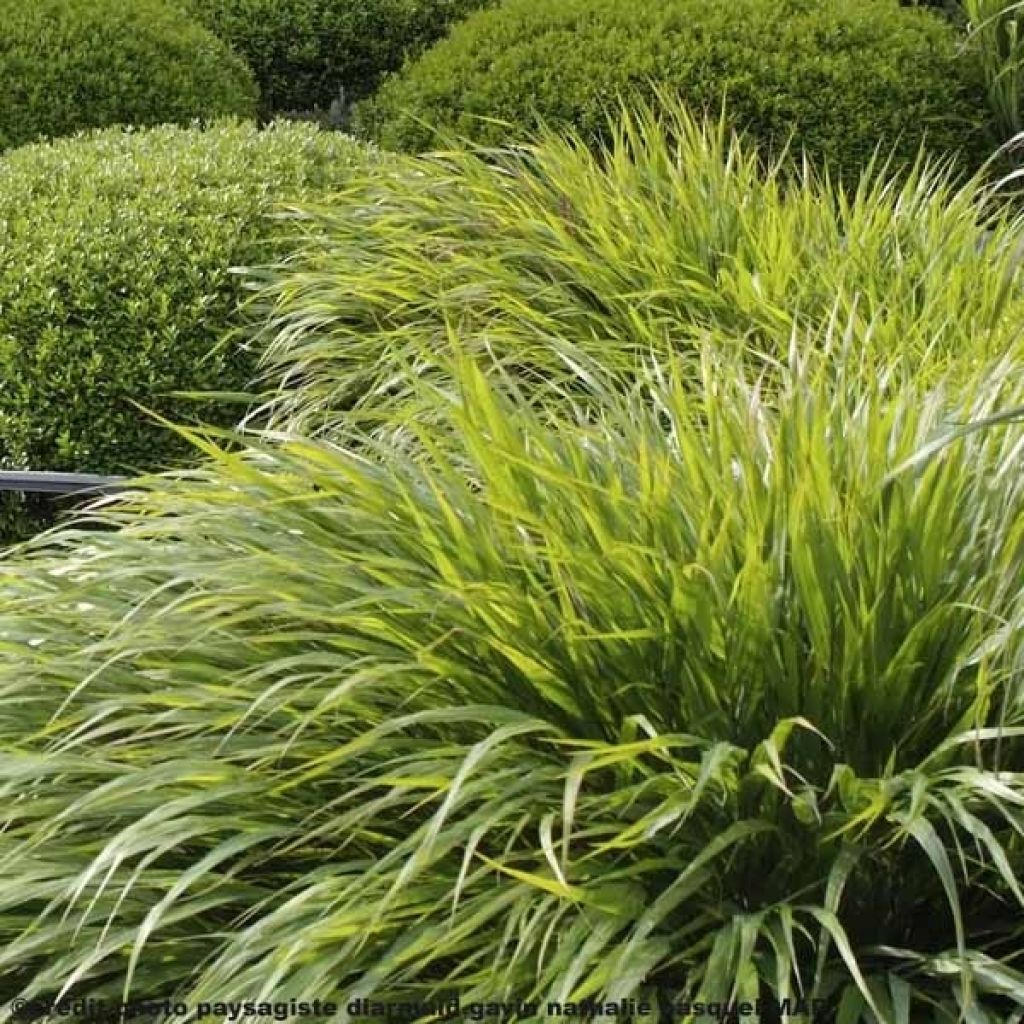

Hakonechloa macra - Japanese Forest Grass
Hakonechloa macra - Japanese Forest Grass
Hakonechloa macra
Japanese Forest Grass
This item cannot be shipped to the selected country
Delivery charge from €5.90
Delivery charge from €5.90
More information
Schedule delivery date,
and select date in basket
This plant carries a 12 months recovery warranty
More information
We guarantee the quality of our plants for a full growing cycle, and will replace at our expense any plant that fails to recover under normal climatic and planting conditions.
From €5.90 for pickup delivery and €6.90 for home delivery
Express home delivery from €8.90.
From €5.90 for pickup delivery and €6.90 for home delivery
Express home delivery from €8.90.
Does this plant fit my garden?
Set up your Plantfit profile →
Description
The Hakonechloa macra, the Japanese grass, is a perennial grass with a remarkable pattern. The plant forms lush clumps of cascading, arching leaves. Its foliage, a fresh green, turns orange tones in the autumn before partially drying out in the winter. Stunning in borders, it can easily be grown in pots and will find a prime spot in a semi-shaded corner of a terrace alongside other shade-loving perennials.
The Hakonechloa macra is a rhizomatous and stoloniferous grass belonging to the poaceae family, and is native to the mountains of Japan. In the wild, it grows on rocky and moist slopes as well as in the undergrowth of the Hakone region. This volcanic massif is the origin of its generic name Hakonechloa and its vernacular name 'Hakone grass'. The plant is hardy down to -15°C (5°F). It forms a rounded, fountain-shaped clump, reaching a height and width of 40cm (16in). It spreads slowly and becomes lush over the years. Like bamboo, the Japanese grass consists of very leafy culms that are initially erect and then drooping, resembling cascading waterfalls and giving the plant a unique appearance. Its growth is rather slow, and the foliage persists throughout the winter in mild climates. The ribbon-like leaves of this grass are a fresh, vibrant green. In autumn, they take on coppery hues, especially if the plant receives some morning sunlight. The flowers appear late in summer or autumn. Arranged in thin spikelets, they are not particularly interesting but can be preserved for winter.
The Hakonechloa macra is perfect for an exotic or Japanese-style garden, a cool rockery, or simply in a pot. This Japanese grass is well-suited to partial shade and humus-rich or clayey soils, even heavy ones that retain moisture in summer. The plant has a trailing habit but is slow to spread, taking time to form large cushions. It thrives when used as a ground cover in shaded parts of the garden, in a light woodland, against an east-facing wall, or to edge a border of shrubs in moist, humus-rich soil, adding roundness and color. The Japanese grass will create a sensation in steep, shady areas of the garden. It is ideal for accompanying hostas, ferns, and heucheras.
Report an error about the product description
Hakonechloa macra - Japanese Forest Grass in pictures
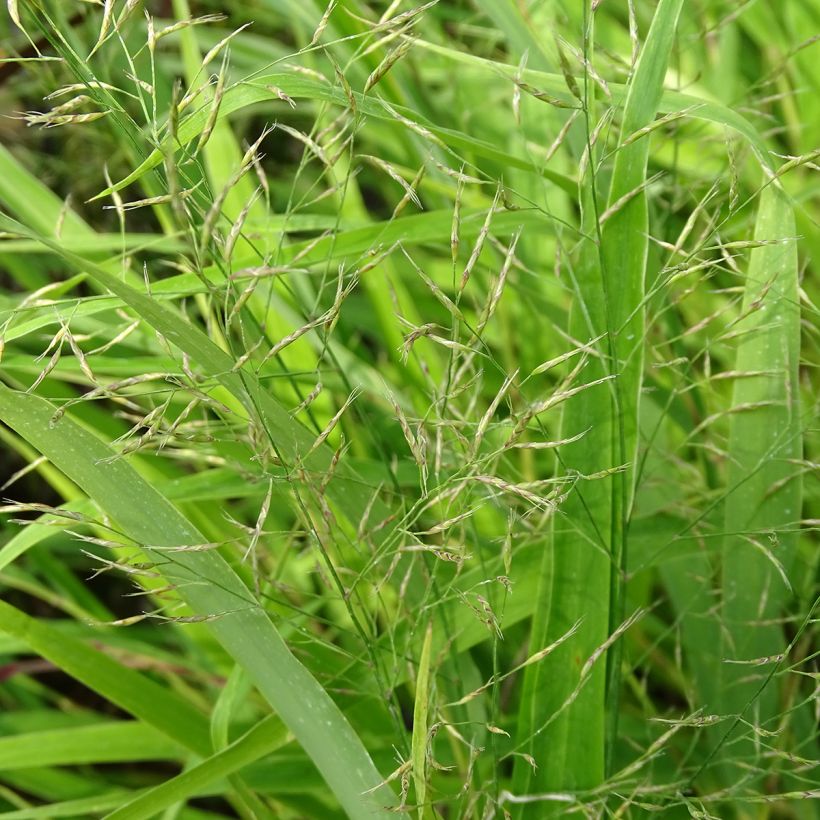

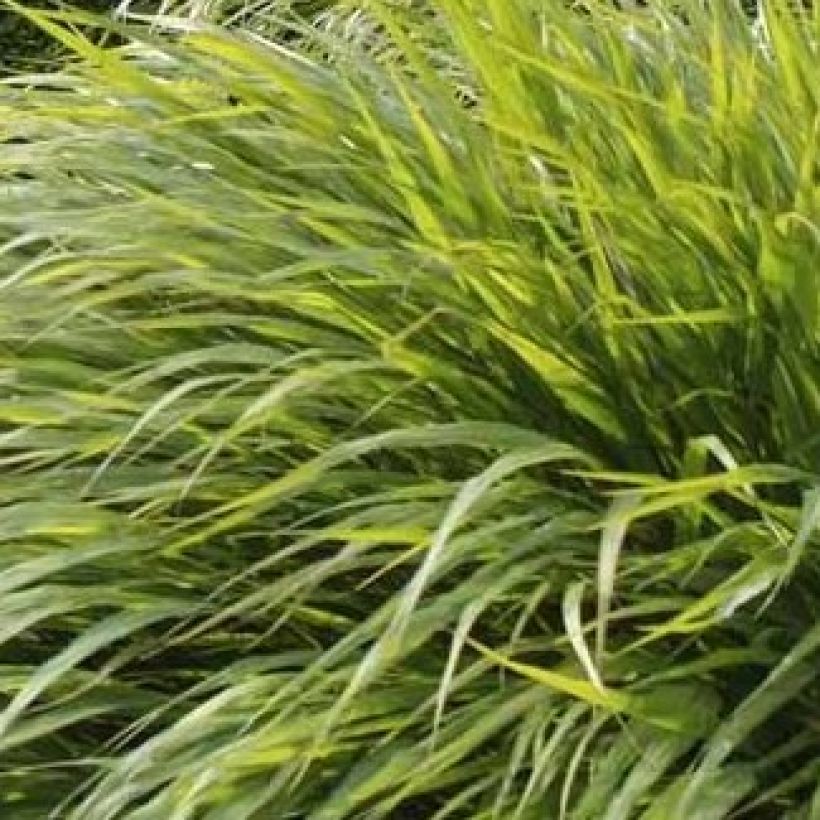

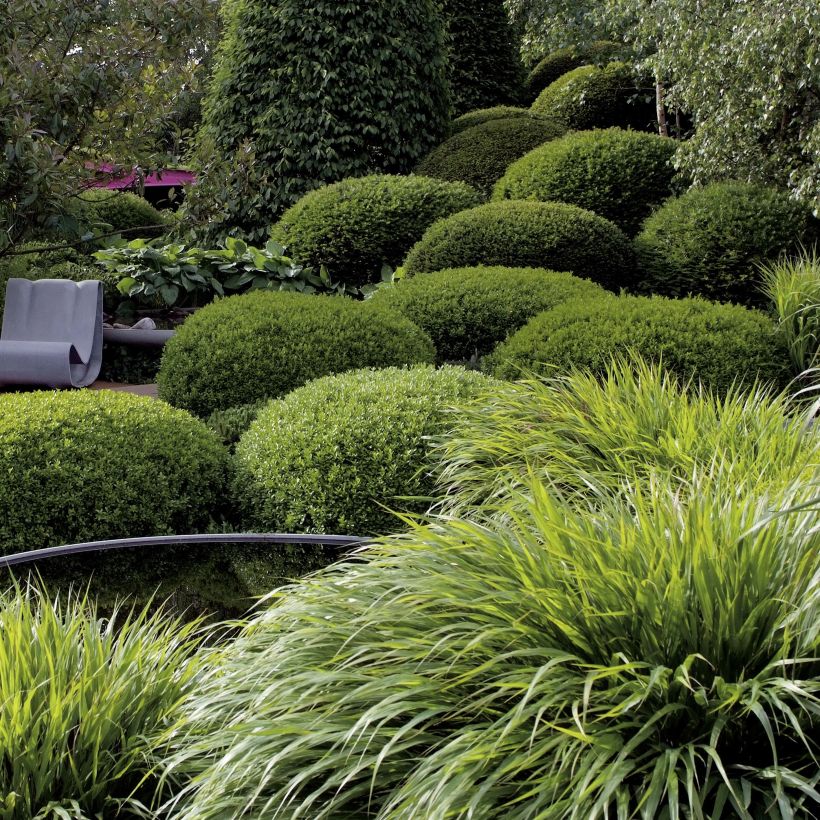

Flowering
Foliage
Plant habit
Botanical data
Hakonechloa
macra
Poaceae
Japanese Forest Grass
West Asia
Other Hakonechloa
Planting and care
For any soil rich in humus, moist but well-drained, with high atmospheric humidity and no harsh cold in winter. These are the conditions it prefers, but the Japanese forest grass adapts quite well to drier environments if it is in the shade. Limestone and dry soils are not suitable for it at all. It can tolerate shade (where its foliage may darken) and accepts morning sun in moist soil. Its autumn foliage will be most vibrant in very bright, but not scorching, exposure. For example, in the morning sun or at the edge of a grove, under dappled sunlight. A spring fertilizer application stimulates the growth of new foliage. Prune your plant in late February before the new leaves emerge. For pot cultivation, ensure regular watering with non-limestone water if possible.
Planting period
Intended location
Care
-
, onOrder confirmed
Reply from on Promesse de fleurs
Shade-loving perennials
Haven't found what you were looking for?
Hardiness is the lowest winter temperature a plant can endure without suffering serious damage or even dying. However, hardiness is affected by location (a sheltered area, such as a patio), protection (winter cover) and soil type (hardiness is improved by well-drained soil).

Photo Sharing Terms & Conditions
In order to encourage gardeners to interact and share their experiences, Promesse de fleurs offers various media enabling content to be uploaded onto its Site - in particular via the ‘Photo sharing’ module.
The User agrees to refrain from:
- Posting any content that is illegal, prejudicial, insulting, racist, inciteful to hatred, revisionist, contrary to public decency, that infringes on privacy or on the privacy rights of third parties, in particular the publicity rights of persons and goods, intellectual property rights, or the right to privacy.
- Submitting content on behalf of a third party;
- Impersonate the identity of a third party and/or publish any personal information about a third party;
In general, the User undertakes to refrain from any unethical behaviour.
All Content (in particular text, comments, files, images, photos, videos, creative works, etc.), which may be subject to property or intellectual property rights, image or other private rights, shall remain the property of the User, subject to the limited rights granted by the terms of the licence granted by Promesse de fleurs as stated below. Users are at liberty to publish or not to publish such Content on the Site, notably via the ‘Photo Sharing’ facility, and accept that this Content shall be made public and freely accessible, notably on the Internet.
Users further acknowledge, undertake to have ,and guarantee that they hold all necessary rights and permissions to publish such material on the Site, in particular with regard to the legislation in force pertaining to any privacy, property, intellectual property, image, or contractual rights, or rights of any other nature. By publishing such Content on the Site, Users acknowledge accepting full liability as publishers of the Content within the meaning of the law, and grant Promesse de fleurs, free of charge, an inclusive, worldwide licence for the said Content for the entire duration of its publication, including all reproduction, representation, up/downloading, displaying, performing, transmission, and storage rights.
Users also grant permission for their name to be linked to the Content and accept that this link may not always be made available.
By engaging in posting material, Users consent to their Content becoming automatically accessible on the Internet, in particular on other sites and/or blogs and/or web pages of the Promesse de fleurs site, including in particular social pages and the Promesse de fleurs catalogue.
Users may secure the removal of entrusted content free of charge by issuing a simple request via our contact form.
The flowering period indicated on our website applies to countries and regions located in USDA zone 8 (France, the United Kingdom, Ireland, the Netherlands, etc.)
It will vary according to where you live:
- In zones 9 to 10 (Italy, Spain, Greece, etc.), flowering will occur about 2 to 4 weeks earlier.
- In zones 6 to 7 (Germany, Poland, Slovenia, and lower mountainous regions), flowering will be delayed by 2 to 3 weeks.
- In zone 5 (Central Europe, Scandinavia), blooming will be delayed by 3 to 5 weeks.
In temperate climates, pruning of spring-flowering shrubs (forsythia, spireas, etc.) should be done just after flowering.
Pruning of summer-flowering shrubs (Indian Lilac, Perovskia, etc.) can be done in winter or spring.
In cold regions as well as with frost-sensitive plants, avoid pruning too early when severe frosts may still occur.
The planting period indicated on our website applies to countries and regions located in USDA zone 8 (France, United Kingdom, Ireland, Netherlands).
It will vary according to where you live:
- In Mediterranean zones (Marseille, Madrid, Milan, etc.), autumn and winter are the best planting periods.
- In continental zones (Strasbourg, Munich, Vienna, etc.), delay planting by 2 to 3 weeks in spring and bring it forward by 2 to 4 weeks in autumn.
- In mountainous regions (the Alps, Pyrenees, Carpathians, etc.), it is best to plant in late spring (May-June) or late summer (August-September).
The harvesting period indicated on our website applies to countries and regions in USDA zone 8 (France, England, Ireland, the Netherlands).
In colder areas (Scandinavia, Poland, Austria...) fruit and vegetable harvests are likely to be delayed by 3-4 weeks.
In warmer areas (Italy, Spain, Greece, etc.), harvesting will probably take place earlier, depending on weather conditions.
The sowing periods indicated on our website apply to countries and regions within USDA Zone 8 (France, UK, Ireland, Netherlands).
In colder areas (Scandinavia, Poland, Austria...), delay any outdoor sowing by 3-4 weeks, or sow under glass.
In warmer climes (Italy, Spain, Greece, etc.), bring outdoor sowing forward by a few weeks.

































